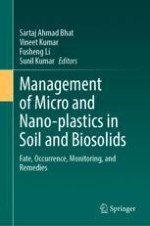2024 | OriginalPaper | Chapter
Occurrence and Fate of Microplastics in Anaerobic Digestion of Dewatered Sludge
Author : Kuok Ho Daniel Tang
Published in: Management of Micro and Nano-plastics in Soil and Biosolids
Publisher: Springer Nature Switzerland
Activate our intelligent search to find suitable subject content or patents.
Select sections of text to find matching patents with Artificial Intelligence. powered by
Select sections of text to find additional relevant content using AI-assisted search. powered by
